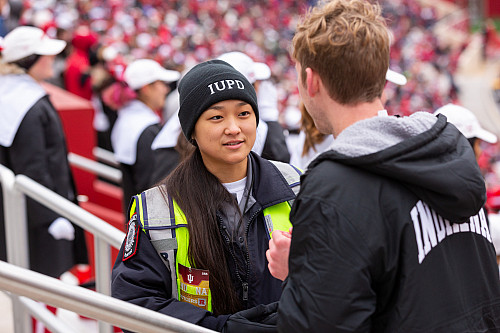IUPD joins national initiative to advance women in policing
By Caroline Dwyer Gilley
June 30, 2022

“The sole purpose of 30x30 is to encourage more women to become police officers,” said IUPD-Bloomington Chief Jill Lees, a co-chair of IUPD’s 30x30 implementation committee. “But more importantly, we want to create a culture to sustain and retain women in law enforcement. It’s critical that we create the policies, culture and environment for women to be successful and feel welcome.”
Currently, 20% of officers across all IUPD divisions statewide are women. That percentage is higher than the national average, where women make up 12% of sworn officers and 3% of police leadership.
One of the central tenets of 30x30 is that the underrepresentation of women in policing undermines public safety, with research suggesting that female officers use less force, are perceived as more honest and compassionate by their communities, and make fewer discretionary arrests.
Lees first heard about 30x30 through her connection to the National Association of Women Law Enforcement Executives, one of 30x30’s partners.
“I immediately wanted to see IUPD sign the pledge,” Lees said. “Signing the pledge puts your feet to the fire. It’s not just lip service; you’re actually trying to work toward an important goal.”
Lees brought 30x30 to the attention of Benjamin Hunter, associate vice president and superintendent of public safety, who became an immediate and strong advocate for signing the pledge. Hunter and Lees then recruited Sgt. Hayley Ciosek to co-chair IUPD’s implementation committee with Lees. The committee includes Maj. Heather Braun, Maj. Laury Flint, officer Aaliyah Porter and Tricia Edwards, director for dispatch communications and chief diversity officer.
The higher percentage of women at IUPD compared to the national average can be attributed, in part, to the cadet officer program, Lees said.
“IUPD does a great job attracting women to become cadets,” said Lees, who began her own career in law enforcement as a cadet at IUPD in 1993.
Ciosek, who also came through IUPD’s cadet officer program, agrees.
“We have always had a lot of women at IUPD,” she said. “Ever since I was a cadet, I have always felt welcome and included, and I saw myself represented in leadership – whether it was Chief Laury Flint at the time, or now Chief Lees. But when I go out and do trainings or talk to people at other agencies, I’m often the only woman in the room, and I feel that.”
As part of the pledge, IUPD will embark on a series of steps to reach its goal of at least 30% female officers by 2030. It will report its beginning demographics from April 2022, when it signed the pledge. The next step will be to distribute an anonymous survey to all sworn female IUPD employees to gauge perceptions. This baseline data will shape plans for the next six months. Ciosek and Hunter will also conduct listening sessions in August with female civilian and sworn staff.
“We want to make sure we’re really listening,” Ciosek said. “We can implement everything that’s part of the initiative, but if we’re not listening to the people on the ground in these jobs then we’re not really getting anything accomplished.”
The next phase will focus on formalizing processes around recruiting, hiring and retaining women, affirming a zero-tolerance policy for discriminatory practices, supporting pregnant and nursing mothers, and ensuring all equipment fits women and there is awareness of its availability.
Mentoring women is another aspect of the initiative that is particularly important to Lees, who also serves on the mentorship committee of the National Association of Women Law Enforcement Executives.
“I sit here today because I’ve had strong mentorship in my life, beginning in high school,” she said. “It’s easier when you come from a family with a legacy of law enforcement; I didn’t have that. That’s why I have an open-door policy for students and always make time for them. I especially like to work with female students and try to take their skills and strengths and help them develop in areas they’re interested in.”
Both Lees and Ciosek said it can be a challenge recruiting women as officers, but IUPD signing the pledge is already having a positive impact during job interviews.
“Candidates are now interviewing agencies to make sure they’re the right fit,” Lees said. “Our involvement with 30x30 is a terrific recruiting tool. It shows women that we care about and will support them, that we will grow and develop them into different ranks within our organization. I really believe women will begin to seek out agencies that are part of 30x30.”
Caroline Dwyer Gilley is public safety communications manager with IU Public Safety.